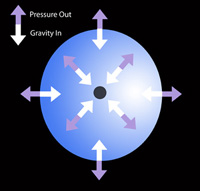
When a star runs out of nuclear fuel, it will collapse. If the core, or central region of the star, has a mass that is greater than three suns, no known nuclear forces can prevent the core from forming a black hole. Anything that comes within a certain distance of the black hole, called the event horizon, cannot escape, not even light. The radius of the event horizon (proportional to the mass) is very small, only 30 kilometers for a non-spinning black hole with the mass of ten suns.
Since a black hole cannot be directly observed, astronomers must use circumstantial evidence to prove its existence. The bottom line is that the observations must imply that a sufficiently large amount of matter is compressed into a sufficiently small region of space so that no other explanation is possible.
How can black holes be located? X-ray observations are extremely useful for finding black holes. The extreme gravity around black holes will produce X-rays when infalling gas is heated to millions of degrees. The best places to look for black holes are regions where large supplies of gas are available, such as double star systems, star forming regions, or the centers of galaxies.
Have different types of black holes been discovered? There is strong evidence for two types of black holes: stellar black holes with masses of a dozen or so suns, and supermassive black holes with masses of many millions of suns. Stellar black holes are formed as a natural consequence of the evolution of massive stars (see 1st paragraph). The origin of supermassive black holes is a mystery. They are found only in the centers of galaxies. It is not known whether they formed in the initial collapse of the gas cloud that formed the galaxy, or from the gradual growth of a stellar mass black hole, or from the merger of a centrally located cluster of black holes, or by some other mechanism.
How do astronomers determine the mass of black holes? The mass of a stellar black hole can be deduced by observing the orbital acceleration of a star as it orbits its unseen companion. Likewise, the mass of a supermassive black hole can be determined by using the orbital acceleration of gas clouds swirling around the central black hole. When orbital acceleration cannot be used to establish the mass of a black hole, astronomers can place a lower limit on its mass by measuring the X-ray luminosity due to matter falling into a black hole. The radiation pressure of the X-rays must be less than the pull of the black hole's gravity. In the case of the black hole discovered in M82, this limits its mass to greater than 500 suns. The M82 black hole is much larger than known stellar black holes, and much smaller than supermassive black holes, thus it is called a "mid-mass" black hole.
What is the significance of a third type of black hole? Astrophysicists had come to believe that galactic centers were the only places where conditions were right for the formation and growth of large or very large black holes. The discovery of a large, mid-mass black hole away from the galaxy's center shows that somehow -- and it is not an easy task theoretically – black holes much more massive than ordinary stellar black holes can form in dense star clusters. Current possible explanations for the formation of mid-mass black holes includes such exotica as black hole mergers or the collapse of a hyperstar. An intriguing implication is that mid-mass black holes could prove to be a common feature in star forming regions of galaxies.
[ Press Index ] [ Fact Sheets ]

